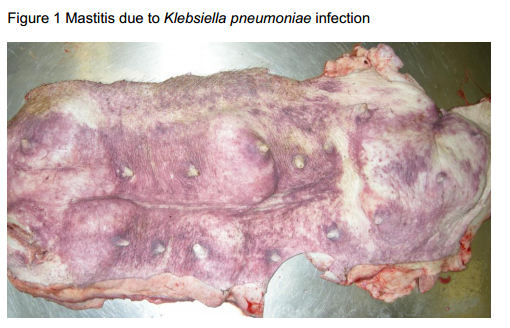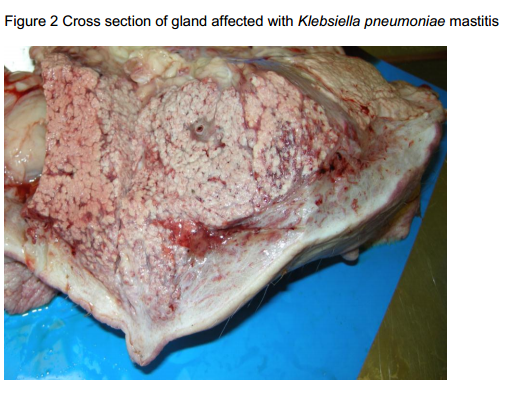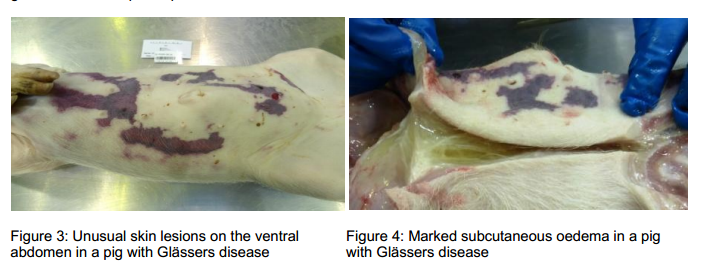



AHVLA Report: Klebsiella Mastitis in Sows in August 2014
UK - The Animal Health Veterinary Laboratories Agency (AHVLA) has looked into outbreaks of reproductive failure due to porcine reproductive and respiratory syndrome, the first Klebsiella pneumoniae septicaemia outbreak associated with mastitis in sows, Glässers disease with severe skin lesions in weaned pigs and Meningitis in growers due to Streptococcus suis type 14.Reproductive Disease
Outbreak of reproductive failure due to PRRS
Porcine reproductive and respiratory syndrome (PRRS) was diagnosed at Bury St Edmunds as the cause of an acute outbreak of late-term abortions in eight sows on a PRRS-vaccinated 200-sow indoor herd. Aborting sows were off-colour, inappetant and pyrexic (40-41°C) for 24-48 hours prior to abortion around a week before they were due. No PRRS virus, or any other infectious agent of abortion was detected in submitted foetuses, but the virus was detected in serum from two of five sows sampled.
Interestingly the two PCR-positive sows were those with the most recent pyrexia and abortion at the time of sampling. Following mass vaccination of the herd, disease has reduced and abortions have stopped, but there are increased returns, and litters of poor viability are still being born, typical of PRRS outbreaks and causing significant economic impact.
Gilts are homebred on the unit and their litters are not affected, raising the possibility that endemic virus has been circulating at a low level in the rearing herd, and disease followed spill-over into the breeding herd, affecting mainly older sows. PRRSv sequencing is in progress to investigate further and compare the current virus with that detected in the past on this unit.
Mixed bacterial pathogens detected in stillborn piglets
Two submissions of stillborn piglets delivered at term were received at Bury St Edmunds to investigate stillbirths occurring in litters from six of 30 sows to have farrowed so far in the batch of 120 on a large outdoor unit.
Affected sows were from a range of parities and were themselves healthy with no concurrent increase in abortions, mummies or weak live-born piglets. The stillborn piglets submitted varied in degree of autolysis. Three organisms were isolated from foetal stomach contents in the first submission (Trueperella pyogenes, Pasteurella pneumotropica and an untypeable Streptococcus suis)and in the second submission, both P. pneumotropica and S. suis were isolated, in pure growth in some foetuses.
These are potential pathogens and are unlikely to be present in stomach contents through environmental contamination or autolysis. All three have been associated with abortions in pigs, although not commonly. Trueperella pyogenes infection may reflect a suppurative focus elsewhere in the sow’s body or could be a secondary suppurative infection in the foetuses.
The occurrence of several pathogens rather than just one does suggest that another factor may be playing a role, and the presence of P. pneumotropica makes it worth reviewing rodent control on the unit as a precaution. Tests for PRRSv and other infectious causes were negative. An update on the clinical situation on farm is expected when the next batch farrow and it was recommended that if problems were ongoing, submission of further foetuses with placentae would be worthwhile to investigate further.
Alimentary Disease
Concurrent Brachyspira and Salmonella infections in finishers
Pooled faecal samples were submitted from 14 to 15-week-old pigs to investigate the cause of weight loss with blood and mucus in the faeces affecting 10 per cent or less of the pigs. Signs had only begun in two days prior to submission of the samples. Brachyspira pilosicoli, B. intermedia and Salmonella Reading were all detected, but not B. hyodysenteriae. Without post-mortem examination, it is not possible to two assess the relative contribution of the B. pilosicoli and the Salmonella isolated, especially as samples were pooled and both can cause enteric disease in pigs and can be co-pathogens.
Respiratory Disease
PRRS with secondary bacterial pneumonia and polyserositis
A ten-week old pig was submitted to Thirsk to investigate a sudden increase in mortality in 30kg growing pigs on a farrow-to-finish unit. Post-mortem examination revealed fibrinous peritonitis, pleuritis, pericarditis suspicious of Glässers disease and generalised lymph node enlargement. There was also red-purple consolidation of the cranial lung lobes and patchy consolidation of caudal lung lobes.
Pasteurella multocida was isolated from affected lung and PRRS virus (Genotype 1 European strain) was also detected. PRRS was diagnosed with likely secondary Pasteurella multocida pneumonia. Pasteurellosis can cause a fibrinous polyserositis and resemble Glässers disease, although Haemophilus parasuis which causes Glässers can be difficult to isolate in culture.
Systemic Disease
Klebsiella pneumoniae septicaemia also associated with mastitis in sows for first time
Following the disease alert circulated about Klebsiella pneumoniae subsp. pneumoniae (Kpp) septicaemia, two outbreaks were diagnosed in East Anglia during August. The first outbreak, diagnosed in early August, was typical and affected well-grown pre-weaned pigs from two-weeks-old on an outdoor breeding herd. The problem had been ongoing for about 12 weeks (last four farrowing batches) prior to submission with a few piglets dying in a few litters from any sow parity; the sows themselves were well.
In the batch from which dead pigs were submitted, 12 three-week-old piglets had died from 1,500 and a few had been found with dyspnoea, in sternal recumbency with reddened eyes shortly before dying. The submitted pigs had red-purple skin discolouration, fibrin stranding in the peritoneal cavities and pinpoint haemorrhages over the intestinal serosae. Pure growths of Kpp were obtained from viscera confirming the diagnosis.
The second Kpp outbreak was typical in that there were sporadic sudden deaths of piglets around threeweeks-old. However the outbreak was unusual and significant in that, just after Kpp was diagnosed in piglets on the unit, several sows in the same farrowing batch as the affected piglets became severely ill, some affected sows were in adjacent farrowing paddocks to each other. Eight sows were affected from the group of 150 which were soon to be weaned, and five died. Affected sows were acutely depressed and inappetant with skin discolouration especially around the perineum, vulva and mammary glands.
Aprompt visit was made by the attending veterinary surgeon who suspected severe toxic mastitis. This was confirmed when a sow was euthanased and submitted. Figures 1 and 2 show the mammary gland lesions – multiple glands were affected and Kpp was isolated in pure growth.
A severe fibrinopurulent mastitis with thrombosis and necrosis was identified by histopathology. The Kpp showed in vitro resistance to ampicillin/amoxicillin only, which reflects innate resistance shown by all Kpp. As a short-term control measure, creep feed medicated with potentiated sulphonamide is being offered to piglets from ten-days-old and prompt treatment of any further suspect mastitis cases with potentiated sulphonamide was recommended by the attending practitioner. No further deaths have occurred to date and future use of an autogenous vaccine is being considered.
Glässers disease with severe skin lesions in weaned pigs
Six-week-old piglets were submitted to Thirsk from a batch of 700 where about 20 had died over a few days. The clinical problem began about five days after weaning with one or two pigs being found dead each day. Affected piglets appeared uncomfortable, with swelling of the ventral skin and inguinal area and sometimes parts of the limbs. The submitted piglets were not pyrexic but walked with a stiff gait.
There was marked pitting oedema of the skin of the ventral abdomen, scrotum and inguinal region and large well demarcated purple areas were present where the skin surface was necrosing as shown in figure 3. The affected skin was cold to the touch and, on incision, thick subcutaneous oedema was revealed as shown in figure 4. There was also evidence of generalised lymphadenopathy and fibrinous pericarditis, pleuritis and peritonitis, typical of Glässers disease which was confirmed by isolation of pure growths of Haemophilus parasuis.
Meningitis in growers due to Streptococcus suis Type 14
Streptococcal meningitis was confirmed as the cause of nervous signs and death of four seven-week-old pigs from a group of 500 over a 10-day period on an indoor rearing unit. There was concern that disease was due to Streptococcus suis type 2, which the pigs were supposed to be free from; however S. suis type 14 was isolated from the meninges of the submitted pig, allaying this concern. This type of S. suis is less common that type 2 but is a recognised primary pathogen. The organism was sensitive to all antimicrobials in the sensitivity test.











